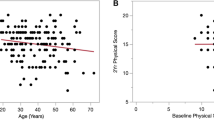Abstract
When trying to assess surgical outcomes at a particular centre, it is important to take account of case mix in terms of the types of operation performed. This is because those centres that undertake a disproportionately high number of complex operations might well be expected to have higher mortality rates than other centres whose case mix is more routine. From a statistical viewpoint, such case-mix adjustment is relatively straightforward if there are reliable risk estimates for different operation types. However this may not be the case and the risk estimates may have to be derived from several different sources which may not themselves be in agreement. Here, standard case-mix adjustment methods are no longer applicable and alternative analysis methods need to be used to make use of such unreliable risk estimates.
Similar content being viewed by others
References
1. The Inquiry into the management of care of children receiving complex heart surgery at the Bristol Royal Infirmary, http://www.bristol-inquiry.org.uk (2000).
2. J. Lovegrove, O. Valencia, T. Treasure, C Sherlaw-Johnson and S. Gallivan, Monitoring the result of cardiac surgery by variable life adjusted display (VLAD), Lancet 350 (1997) 1128–1130.
3. J. Lovegrove, C. Sherlaw-Johnson and S. Gallivan, Monitoring the performance of cardiac surgeons, Journal of the Operational Research Society 50(7) (1998) 684–689.
4. C. Sherlaw-Johnson, J. Lovegrove, T. Treasure and S. Gallivan, Likely variations in perioperative mortality associated with cardiac surgery: When does high mortality reflect bad practice? Heart 84 (2000) 79–82.
5. B. Keogh and R. Kinsman, National adult cardiac data base report 1990–2000 The Society of Cardiothoracic Surgeons of Great Britain and Ireland, 2000.
6. T. Treasure, O. Valencia, C. Sherlaw-Johnson and S. Gallivan, Surgical performance measurement, Health Care Management Science 5 (2002) 243–248.
7. D.J. Spiegelhalter, S. Evans, P. Aylin, and J. Murray, Overview of statistical evidence presented to the Bristol Royal Infirmary Inquiry concerning the nature and outcomes of paediatric cardiac surgical services at Bristol relative to other specialist centres from 1984 to 1995, in: The Bristol Royal Infirmary Inquiry. Learning from Bristol. The Report of the Public Inquiry into children’s heart surgery at the Bristol Royal Infirmary 1984-1995 (The Stationery Office, London, Annex B, 2001).
Author information
Authors and Affiliations
Corresponding author
Rights and permissions
About this article
Cite this article
Gallivan, S. Assessing Mortality Rates from Dubious Data—When to Stop Doing Statistics and Start Doing Mathematics. Health Care Manage Sci 8, 237–241 (2005). https://doi.org/10.1007/s10729-005-2015-9
Issue Date:
DOI: https://doi.org/10.1007/s10729-005-2015-9




